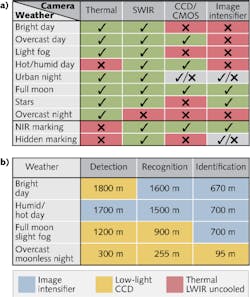IR IMAGING: SWIR cameras spot unwanted activities through fog and at night
Around-the-clock surveillance in any weather is a necessity for many military and emergency services. Often intruders try to disguise their actions using various methods of camouflage that they adapt to the prevailing situation. They exploit atmospheric conditions such as haze, fog, or sandstorms and may even deploy smoke grenades.
Surrounding conditions can vary widely, from glaring daylight of 100,000 lux to a dim twilight at dusk and dawn to total darkness in moonless nights and overcast skies with an illuminance of less than 0.01 lux. Changing light incidence, blinding by a low sun or moon, and temporal and directional variances in light intensity in urban areas caused by street lights and traffic flows can make it difficult to identify an attacker hiding, for example, in a dark doorway. In a typical surveillance application, the available light must suffice, as any active illumination would alert intruders to impending countermeasures.
The impact of haze and smoke disappears in the short-wave infrared (SWIR) range stretching from 0.9 to about 1.7 μm. Although image capture in the SWIR misses the color content of the visible realm, SWIR images, which are formed by light reflected by the objects observed, can be interpreted as easily and directly as those in the visible realm. An added advantage of SWIR image sensors is their high sensitivity and wide dynamic range.
Another highly transparent atmospheric window exists in the long-wave infrared (LWIR) range between 8 and 14 μm. It can be used to capture the thermal radiation of warm objects such as animals or people. The LWIR window has long been used for reconnaissance tasks in the detection, recognition and identification of objects.
One drawback of LWIR reconnaissance is that reflecting objects are not easily recognized and depicted. This complicates the interpretation of LWIR images. Another drawback is the substantial attenuation of LWIR in hot weather and high humidity and its total absorption by regular glass lenses. Thus, special glass materials are required for LWIR cameras, whereas SWIR cameras use conventional
optics. It can be advantageous to combine both wavelength areas in one imaging system.
For example, Xenics (Leuven, Belgium) has developed a family of high-resolution IR camera modules called Xenics Cores, which can be combined and integrated in a common platform. These cameras deliver parallel images that can be overlaid and fused to a spectral composite with increased content under all weather and light conditions A high-resolution SWIR camera module (XSW-640) and thermal LWIR module (XTM-640) are easily combined for overlay imaging. Both are lightweight at less than 100 grams and consume less than 2 W of power.
Singapore-based sInfraRed has investigated the suitability of various sensor technologies for such applications. As sInfraRed CEO Raf Vandersmissen explains, several test series were carried out at various sites at different times of day and night under clear skies, fog, and smoke. Four technologies were investigated: a residual-light amplifier (Gen. II); CCD and CMOS image sensors highly sensitive to visible light; an indium gallium arsenide (InGaAs) SWIR camera (0.9 to 1.7 μm); and an uncooled microbolometer for thermal LWIR image capture (8 to 14 μm).
Residual-light amplifiers excel at clear skies and moonlight, boosted by the airglow phenomenon (an atmospheric phenomenon occurring in clear skies, which extends far into the SWIR). Airglow centers on a wavelength of 1.6 μm, which makes it even more interesting for SWIR imaging. However, the stark contrast between artificial light sources encountered in urban environments can blind the sensors of residual-light amplifiers. The same can happen in bright daylight.
The dynamic range of CCD and CMOS imagers is somewhat larger; therefore, they can also be used on overcast days. Operating in the visible portion of the spectrum, they tend to degrade in haze and fog. Also, their sensitivity is not sufficient on dark nights with just starlight present.
The large dynamic range of SWIR imagers, which suits them for many applications, is determined by three favorable parameters: InGaAs technology offering dynamic, overdrive-resistant exposure control, atmospheric transparency despite haze and smoke, and the exploitation of airglow illumination. At this wavelength, moonlight and airglow are comparable in terms of their power measured in photon units. Thus, an SWIR camera will reach its limits at nighttime and overcast skies with no airglow present.
LWIR cameras are much less sensitive to the reflected light of objects since they respond to the thermal emissions of self-radiating objects; they are usable on moonless nights and under overcast skies, although on hot days their performance is affected by high atmospheric humidity.
Vandersmissen notes that in a second test series sequence undertaken by sInfraRed and a customer, the performance of these different technologies was quantified and compared to establish the validity specifically of SWIR cameras for reconnaissance purposes. The SWIR camera tested was equipped with an InGaAs sensor array of 640 × 512 pixels and 20 μm pixel pitch. It was thermoelectrically cooled and was fitted with a 100 mm SWIR lens.
Quantitative results under four typical weather conditions are summarized in Fig. 1b. The SWIR sensor ranks highly in comparison to its competitors: uncooled thermal LWIR sensor, CCD camera, and residual-light amplifier. SWIR takes first place six times, and second place six times as well. There is no other camera technology reaching a better position, notes Vandersmissen.
Vandersmissen points out that among the specific capabilities of SWIR imagers is hidden marking. This technique identifies friendly personnel to protect them against the much-dreaded “friendly fire.” Its recognition performance is shown in the two lowest lines of Fig. 1a.
About the Author
John Wallace
Senior Technical Editor (1998-2022)
John Wallace was with Laser Focus World for nearly 25 years, retiring in late June 2022. He obtained a bachelor's degree in mechanical engineering and physics at Rutgers University and a master's in optical engineering at the University of Rochester. Before becoming an editor, John worked as an engineer at RCA, Exxon, Eastman Kodak, and GCA Corporation.

